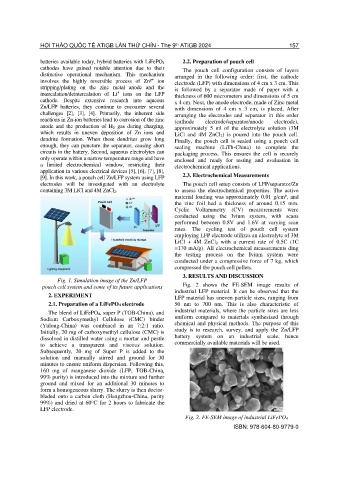Page 166 - Kỷ yếu hội thảo quốc tế: Ứng dụng công nghệ mới trong công trình xanh - lần thứ 9 (ATiGB 2024)
P. 166
th
HỘI THẢO QUỐC TẾ ATiGB LẦN THỨ CHÍN - The 9 ATiGB 2024 157
batteries available today, hybrid batteries with LiFePO4 2.2. Preparation of pouch cell
cathodes have gained notable attention due to their The pouch cell configuration consists of layers
distinctive operational mechanism. This mechanism arranged in the following order: first, the cathode
involves the highly reversible process of Zn²⁺ ion electrode (LFP) with dimensions of 4 cm x 3 cm. This
stripping/plating on the zinc metal anode and the is followed by a separator made of paper with a
intercalation/deintercalation of Li⁺ ions on the LFP thickness of 600 micrometers and dimensions of 5 cm
cathode. Despite extensive research into aqueous x 4 cm. Next, the anode electrode, made of Zinc metal
Zn/LFP batteries, they continue to encounter several with dimensions of 4 cm x 3 cm, is placed. After
challenges [2], [3], [4]. Primarily, the inherent side arranging the electrodes and separator in this order
reactions in Zn-ion batteries lead to corrosion of the zinc (cathode electrode/separator/anode electrode),
anode and the production of H₂ gas during charging, approximately 5 ml of the electrolyte solution (3M
which results in uneven deposition of Zn ions and LiCl and 4M ZnCl2) is poured into the pouch cell.
dendrite formation. When these dendrites grow long Finally, the pouch cell is sealed using a pouch cell
enough, they can puncture the separator, causing short sealing machine (LiTh-China) to complete the
circuits in the battery. Second, aqueous electrolytes can packaging process. This ensures the cell is securely
only operate within a narrow temperature range and have enclosed and ready for testing and evaluation in
a limited electrochemical window, restricting their electrochemical applications.
application in various electrical devices [5], [6], [7], [8],
[9]. In this work, a pouch cell Zn/LFP system using LFP 2.3. Electrochemical Measurements
electrodes will be investigated with an electrolyte The pouch cell setup consists of LFP/separator/Zn
containing 3M LiCl and 4M ZnCl2. to assess the electrochemical properties. The active
material loading was approximately 0.01 g/cm², and
the zinc foil had a thickness of around 0.15 mm.
Cyclic Voltammetry (CV) measurements were
conducted using the Ivium system, with scans
performed between 0.8V and 1.6V at varying scan
rates. The cycling test of pouch cell system
employing LFP electrode utilizes an electrolyte of 3M
LiCl + 4M ZnCl2 with a current rate of 0.5C (1C
=170 mA/g). All electrochemical measurements ding
the testing process on the Ivium system were
conducted under a compressive force of 7 kg, which
compressed the pouch cell pellets.
3. RESULTS AND DISCUSSION
Fig. 1. Simulation image of the Zn/LFP
pouch cell system and some of its future applications Fig. 2 shows the FE-SEM image results of
industrial LFP material. It can be observed that the
2. EXPERIMENT LFP material has uneven particle sizes, ranging from
2.1. Preparation of a LiFePO4 electrode 50 nm to 700 nm. This is also characteristic of
The blend of LiFePO4, super P (TOB-China), and industrial materials, where the particle sizes are less
Sodium Carboxymethyl Cellulose (CMC) binder uniform compared to materials synthesized through
(Yulong-China) was combined in an 7:2:1 ratio. chemical and physical methods. The purpose of this
Initially, 20 mg of carboxymethyl cellulose (CMC) is study is to research, survey, and apply the Zn/LFP
dissolved in distilled water using a mortar and pestle battery system on an industrial scale, hence
to achieve a transparent and viscous solution. commercially available materials will be used.
Subsequently, 20 mg of Super P is added to the
solution and manually stirred and ground for 30
minutes to ensure uniform dispersion. Following this,
160 mg of manganese dioxide (LFP, TOB-China,
99% purity) is introduced into the mixture and further
ground and mixed for an additional 30 minutes to
form a homogeneous slurry. The slurry is then doctor-
bladed onto a carbon cloth (Hangzhou-China, purity
99%) and dried at 60°C for 2 hours to fabricate the
LFP electrode.
Fig. 2. FE-SEM image of industrial LiFePO4
ISBN: 978-604-80-9779-0

